Budget Management
VerifiedAdded on 2023/04/20
|17
|3930
|69
AI Summary
This document provides an overview of budget management, including the impact of external and internal factors on budgetary planning, strategies for managing budget variance, and analyzing cost information in business. It also discusses the relationship between functional departments and responsibility centers. The document includes a table of contents and covers various tasks related to budget management. The content is relevant for students studying finance or business management courses.
Contribute Materials
Your contribution can guide someone’s learning journey. Share your
documents today.
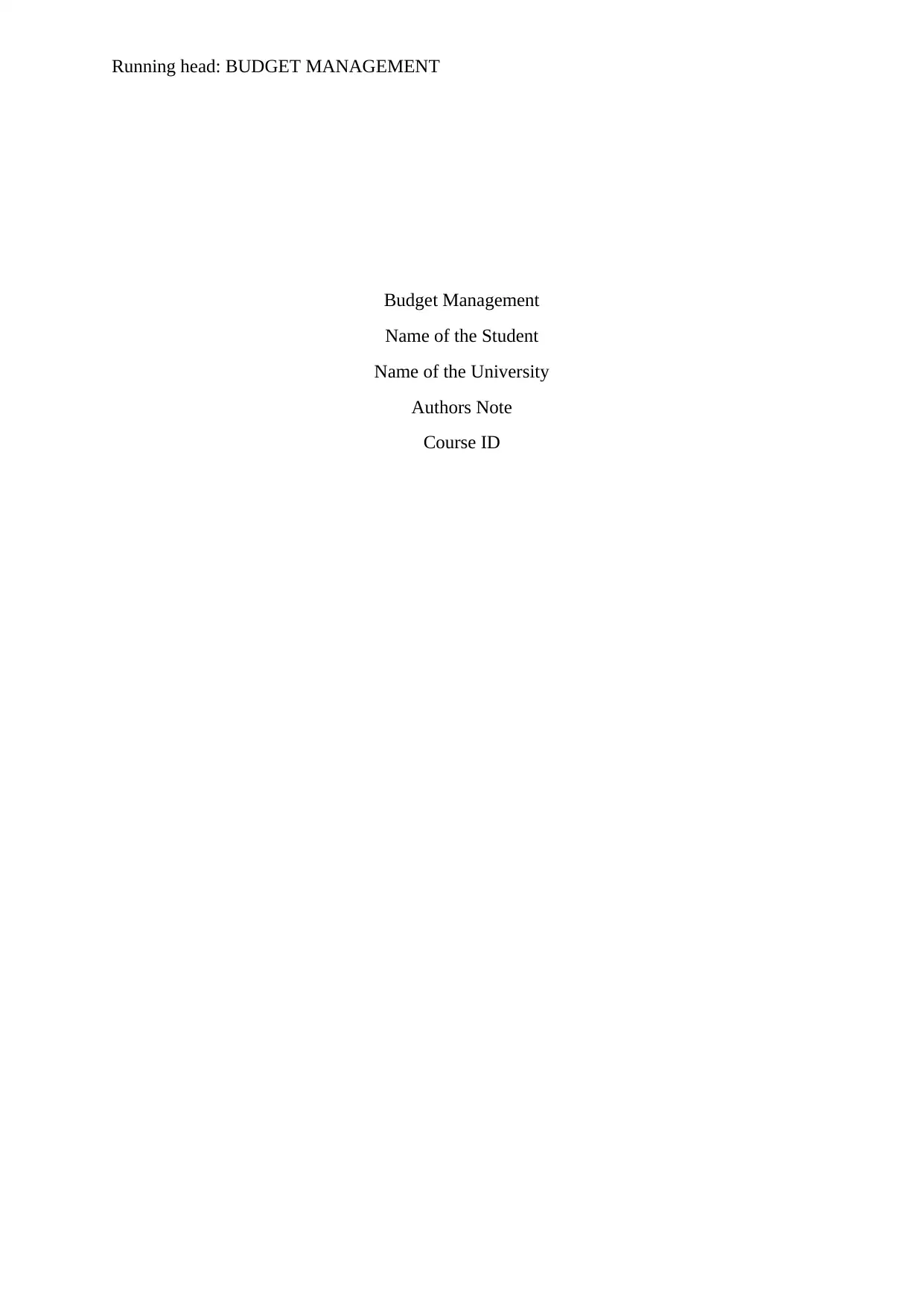
Running head: BUDGET MANAGEMENT
Budget Management
Name of the Student
Name of the University
Authors Note
Course ID
Budget Management
Name of the Student
Name of the University
Authors Note
Course ID
Secure Best Marks with AI Grader
Need help grading? Try our AI Grader for instant feedback on your assignments.
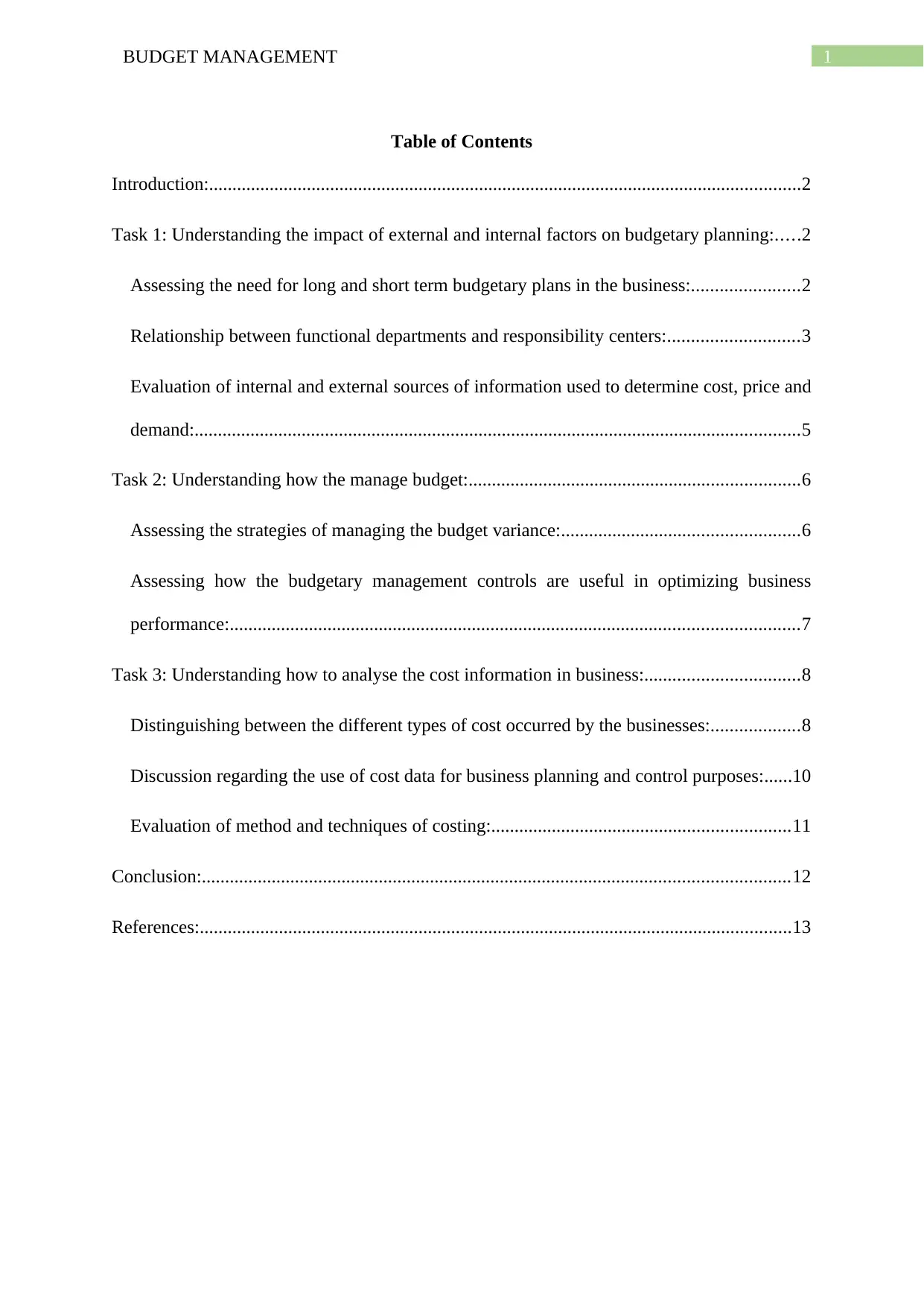
1BUDGET MANAGEMENT
Table of Contents
Introduction:...............................................................................................................................2
Task 1: Understanding the impact of external and internal factors on budgetary planning:.....2
Assessing the need for long and short term budgetary plans in the business:.......................2
Relationship between functional departments and responsibility centers:............................3
Evaluation of internal and external sources of information used to determine cost, price and
demand:..................................................................................................................................5
Task 2: Understanding how the manage budget:.......................................................................6
Assessing the strategies of managing the budget variance:...................................................6
Assessing how the budgetary management controls are useful in optimizing business
performance:..........................................................................................................................7
Task 3: Understanding how to analyse the cost information in business:.................................8
Distinguishing between the different types of cost occurred by the businesses:...................8
Discussion regarding the use of cost data for business planning and control purposes:......10
Evaluation of method and techniques of costing:................................................................11
Conclusion:..............................................................................................................................12
References:...............................................................................................................................13
Table of Contents
Introduction:...............................................................................................................................2
Task 1: Understanding the impact of external and internal factors on budgetary planning:.....2
Assessing the need for long and short term budgetary plans in the business:.......................2
Relationship between functional departments and responsibility centers:............................3
Evaluation of internal and external sources of information used to determine cost, price and
demand:..................................................................................................................................5
Task 2: Understanding how the manage budget:.......................................................................6
Assessing the strategies of managing the budget variance:...................................................6
Assessing how the budgetary management controls are useful in optimizing business
performance:..........................................................................................................................7
Task 3: Understanding how to analyse the cost information in business:.................................8
Distinguishing between the different types of cost occurred by the businesses:...................8
Discussion regarding the use of cost data for business planning and control purposes:......10
Evaluation of method and techniques of costing:................................................................11
Conclusion:..............................................................................................................................12
References:...............................................................................................................................13
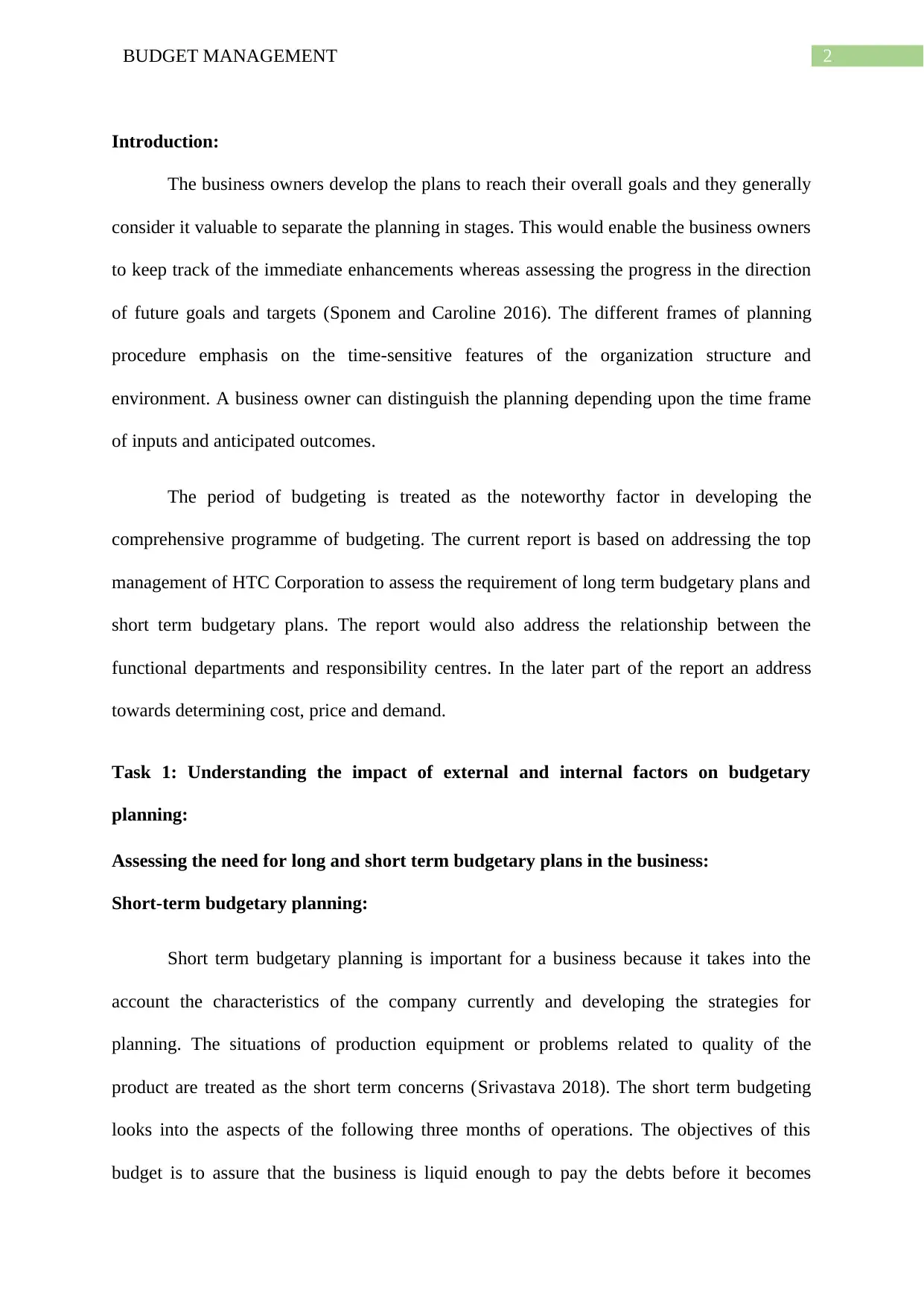
2BUDGET MANAGEMENT
Introduction:
The business owners develop the plans to reach their overall goals and they generally
consider it valuable to separate the planning in stages. This would enable the business owners
to keep track of the immediate enhancements whereas assessing the progress in the direction
of future goals and targets (Sponem and Caroline 2016). The different frames of planning
procedure emphasis on the time-sensitive features of the organization structure and
environment. A business owner can distinguish the planning depending upon the time frame
of inputs and anticipated outcomes.
The period of budgeting is treated as the noteworthy factor in developing the
comprehensive programme of budgeting. The current report is based on addressing the top
management of HTC Corporation to assess the requirement of long term budgetary plans and
short term budgetary plans. The report would also address the relationship between the
functional departments and responsibility centres. In the later part of the report an address
towards determining cost, price and demand.
Task 1: Understanding the impact of external and internal factors on budgetary
planning:
Assessing the need for long and short term budgetary plans in the business:
Short-term budgetary planning:
Short term budgetary planning is important for a business because it takes into the
account the characteristics of the company currently and developing the strategies for
planning. The situations of production equipment or problems related to quality of the
product are treated as the short term concerns (Srivastava 2018). The short term budgeting
looks into the aspects of the following three months of operations. The objectives of this
budget is to assure that the business is liquid enough to pay the debts before it becomes
Introduction:
The business owners develop the plans to reach their overall goals and they generally
consider it valuable to separate the planning in stages. This would enable the business owners
to keep track of the immediate enhancements whereas assessing the progress in the direction
of future goals and targets (Sponem and Caroline 2016). The different frames of planning
procedure emphasis on the time-sensitive features of the organization structure and
environment. A business owner can distinguish the planning depending upon the time frame
of inputs and anticipated outcomes.
The period of budgeting is treated as the noteworthy factor in developing the
comprehensive programme of budgeting. The current report is based on addressing the top
management of HTC Corporation to assess the requirement of long term budgetary plans and
short term budgetary plans. The report would also address the relationship between the
functional departments and responsibility centres. In the later part of the report an address
towards determining cost, price and demand.
Task 1: Understanding the impact of external and internal factors on budgetary
planning:
Assessing the need for long and short term budgetary plans in the business:
Short-term budgetary planning:
Short term budgetary planning is important for a business because it takes into the
account the characteristics of the company currently and developing the strategies for
planning. The situations of production equipment or problems related to quality of the
product are treated as the short term concerns (Srivastava 2018). The short term budgeting
looks into the aspects of the following three months of operations. The objectives of this
budget is to assure that the business is liquid enough to pay the debts before it becomes
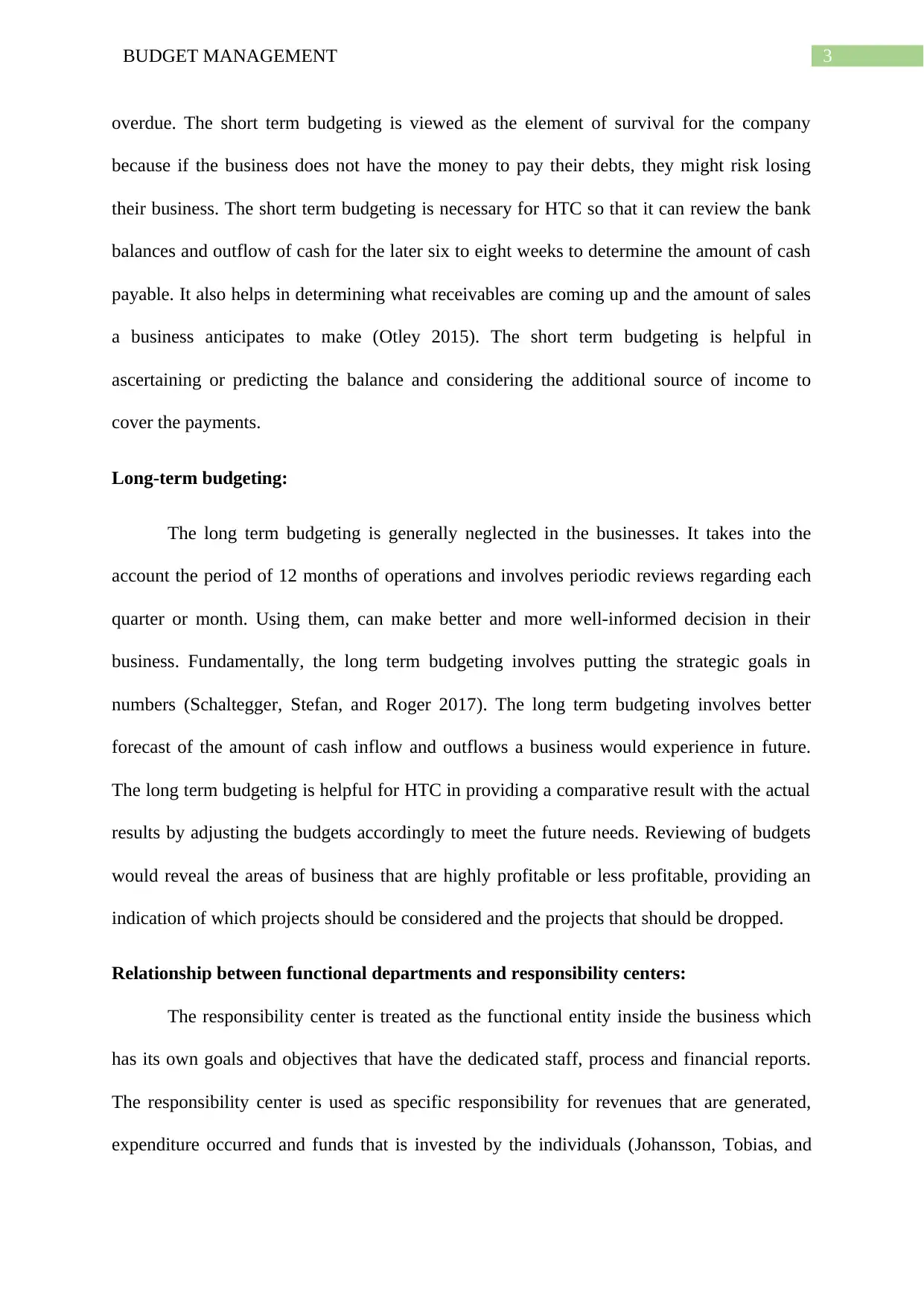
3BUDGET MANAGEMENT
overdue. The short term budgeting is viewed as the element of survival for the company
because if the business does not have the money to pay their debts, they might risk losing
their business. The short term budgeting is necessary for HTC so that it can review the bank
balances and outflow of cash for the later six to eight weeks to determine the amount of cash
payable. It also helps in determining what receivables are coming up and the amount of sales
a business anticipates to make (Otley 2015). The short term budgeting is helpful in
ascertaining or predicting the balance and considering the additional source of income to
cover the payments.
Long-term budgeting:
The long term budgeting is generally neglected in the businesses. It takes into the
account the period of 12 months of operations and involves periodic reviews regarding each
quarter or month. Using them, can make better and more well-informed decision in their
business. Fundamentally, the long term budgeting involves putting the strategic goals in
numbers (Schaltegger, Stefan, and Roger 2017). The long term budgeting involves better
forecast of the amount of cash inflow and outflows a business would experience in future.
The long term budgeting is helpful for HTC in providing a comparative result with the actual
results by adjusting the budgets accordingly to meet the future needs. Reviewing of budgets
would reveal the areas of business that are highly profitable or less profitable, providing an
indication of which projects should be considered and the projects that should be dropped.
Relationship between functional departments and responsibility centers:
The responsibility center is treated as the functional entity inside the business which
has its own goals and objectives that have the dedicated staff, process and financial reports.
The responsibility center is used as specific responsibility for revenues that are generated,
expenditure occurred and funds that is invested by the individuals (Johansson, Tobias, and
overdue. The short term budgeting is viewed as the element of survival for the company
because if the business does not have the money to pay their debts, they might risk losing
their business. The short term budgeting is necessary for HTC so that it can review the bank
balances and outflow of cash for the later six to eight weeks to determine the amount of cash
payable. It also helps in determining what receivables are coming up and the amount of sales
a business anticipates to make (Otley 2015). The short term budgeting is helpful in
ascertaining or predicting the balance and considering the additional source of income to
cover the payments.
Long-term budgeting:
The long term budgeting is generally neglected in the businesses. It takes into the
account the period of 12 months of operations and involves periodic reviews regarding each
quarter or month. Using them, can make better and more well-informed decision in their
business. Fundamentally, the long term budgeting involves putting the strategic goals in
numbers (Schaltegger, Stefan, and Roger 2017). The long term budgeting involves better
forecast of the amount of cash inflow and outflows a business would experience in future.
The long term budgeting is helpful for HTC in providing a comparative result with the actual
results by adjusting the budgets accordingly to meet the future needs. Reviewing of budgets
would reveal the areas of business that are highly profitable or less profitable, providing an
indication of which projects should be considered and the projects that should be dropped.
Relationship between functional departments and responsibility centers:
The responsibility center is treated as the functional entity inside the business which
has its own goals and objectives that have the dedicated staff, process and financial reports.
The responsibility center is used as specific responsibility for revenues that are generated,
expenditure occurred and funds that is invested by the individuals (Johansson, Tobias, and
Secure Best Marks with AI Grader
Need help grading? Try our AI Grader for instant feedback on your assignments.
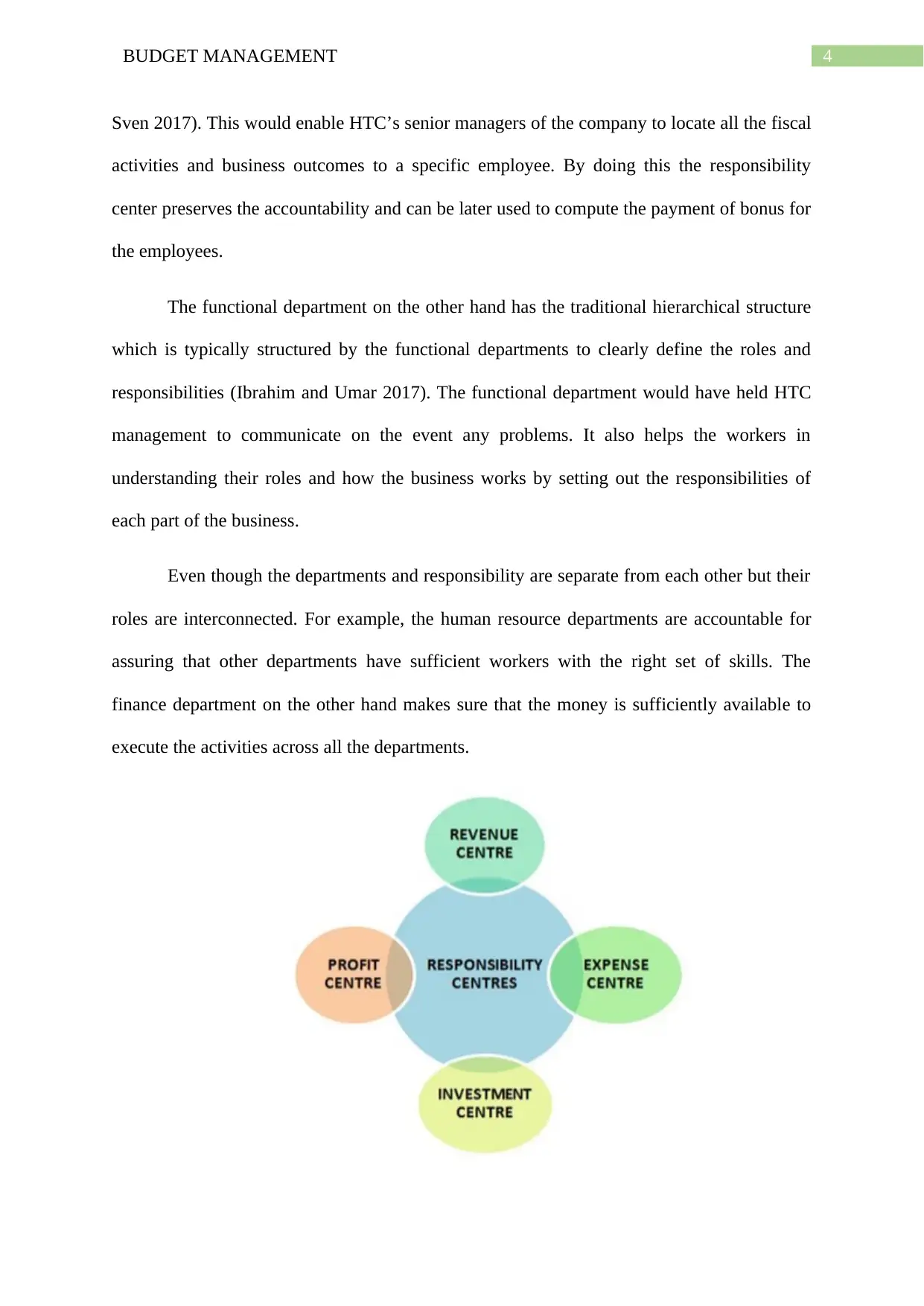
4BUDGET MANAGEMENT
Sven 2017). This would enable HTC’s senior managers of the company to locate all the fiscal
activities and business outcomes to a specific employee. By doing this the responsibility
center preserves the accountability and can be later used to compute the payment of bonus for
the employees.
The functional department on the other hand has the traditional hierarchical structure
which is typically structured by the functional departments to clearly define the roles and
responsibilities (Ibrahim and Umar 2017). The functional department would have held HTC
management to communicate on the event any problems. It also helps the workers in
understanding their roles and how the business works by setting out the responsibilities of
each part of the business.
Even though the departments and responsibility are separate from each other but their
roles are interconnected. For example, the human resource departments are accountable for
assuring that other departments have sufficient workers with the right set of skills. The
finance department on the other hand makes sure that the money is sufficiently available to
execute the activities across all the departments.
Sven 2017). This would enable HTC’s senior managers of the company to locate all the fiscal
activities and business outcomes to a specific employee. By doing this the responsibility
center preserves the accountability and can be later used to compute the payment of bonus for
the employees.
The functional department on the other hand has the traditional hierarchical structure
which is typically structured by the functional departments to clearly define the roles and
responsibilities (Ibrahim and Umar 2017). The functional department would have held HTC
management to communicate on the event any problems. It also helps the workers in
understanding their roles and how the business works by setting out the responsibilities of
each part of the business.
Even though the departments and responsibility are separate from each other but their
roles are interconnected. For example, the human resource departments are accountable for
assuring that other departments have sufficient workers with the right set of skills. The
finance department on the other hand makes sure that the money is sufficiently available to
execute the activities across all the departments.

5BUDGET MANAGEMENT
Figure 1: Figure representing the Responsibility Center
(Source: Kamal 2015)
There are goals of every functional departments and if the business is to be successful
then these objectives are tied closely with the responsibility department. On the other hand,
from the perspective of accounting, the financial report must be issued to each responsibility
center that itemizes the expenditure, revenues and profits to which each functional
department is entirely responsible (Kaplan, Robert and Anthony 2016). The goals under the
functional department and responsibility center is carefully coordinated to make sure that
they are consistent with the corporate objectives and working altogether to attain the overall
organizational objectives.
Evaluation of internal and external sources of information used to determine cost, price
and demand:
The internal and external sources of information that is used to determine the cost,
price and demand are as follows;
Internal sources of information:
Firms reputation: The price and demand of the product may be determined based on the
reputation of company in the market. For example, a company like HTC can demand for
higher price for their brands as the company can enjoy goodwill in the marketplace.
Product life cycle: The stage on which the product is in its product life cycle also create an
impact on the price and demand of the product (Kohlmeyer et al. 2015). For example, during
the HTC’s stage of product introduction the firm might charge low price so that it can attract
the customers and during the stage of growth a business might raise the price.
Figure 1: Figure representing the Responsibility Center
(Source: Kamal 2015)
There are goals of every functional departments and if the business is to be successful
then these objectives are tied closely with the responsibility department. On the other hand,
from the perspective of accounting, the financial report must be issued to each responsibility
center that itemizes the expenditure, revenues and profits to which each functional
department is entirely responsible (Kaplan, Robert and Anthony 2016). The goals under the
functional department and responsibility center is carefully coordinated to make sure that
they are consistent with the corporate objectives and working altogether to attain the overall
organizational objectives.
Evaluation of internal and external sources of information used to determine cost, price
and demand:
The internal and external sources of information that is used to determine the cost,
price and demand are as follows;
Internal sources of information:
Firms reputation: The price and demand of the product may be determined based on the
reputation of company in the market. For example, a company like HTC can demand for
higher price for their brands as the company can enjoy goodwill in the marketplace.
Product life cycle: The stage on which the product is in its product life cycle also create an
impact on the price and demand of the product (Kohlmeyer et al. 2015). For example, during
the HTC’s stage of product introduction the firm might charge low price so that it can attract
the customers and during the stage of growth a business might raise the price.
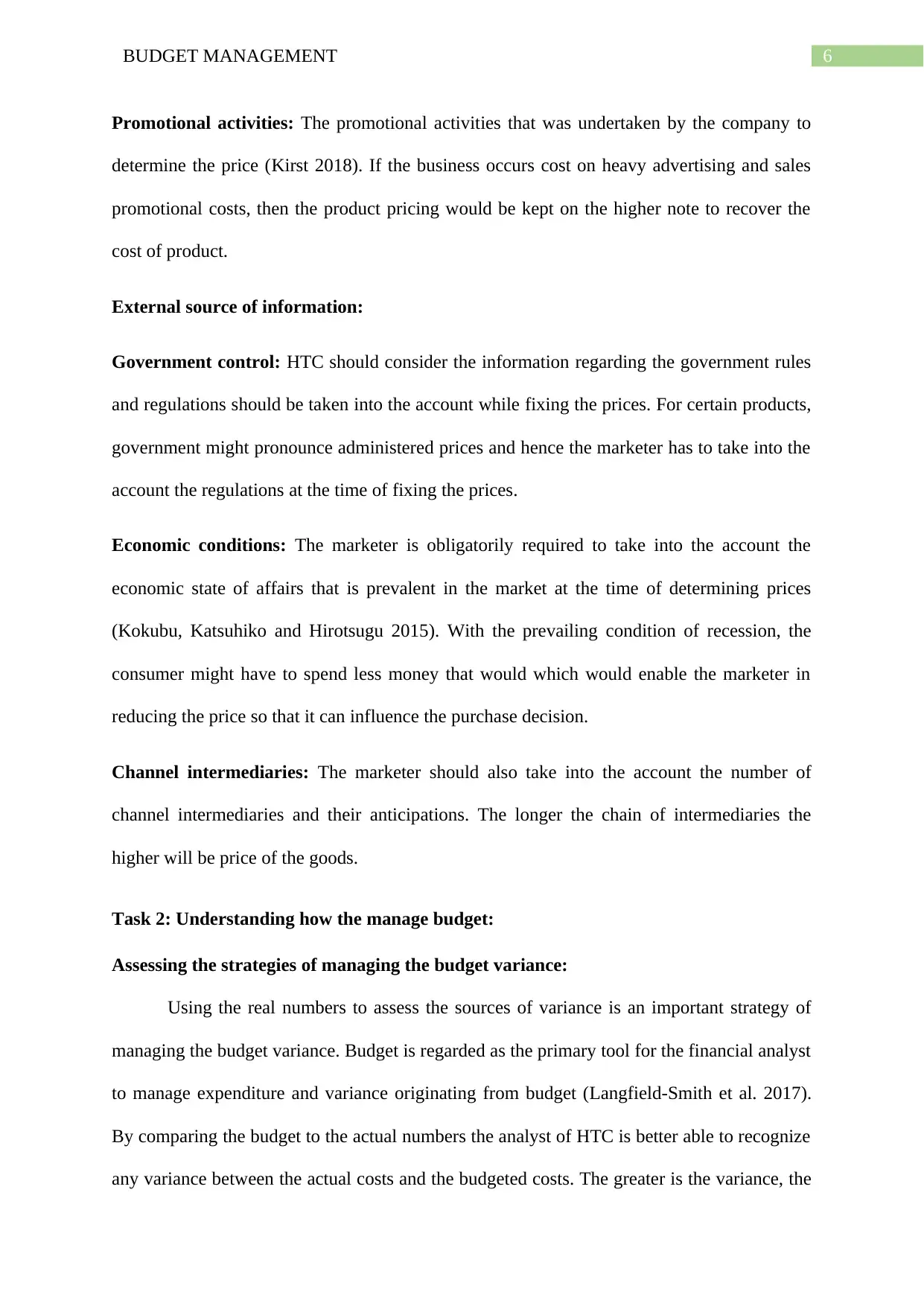
6BUDGET MANAGEMENT
Promotional activities: The promotional activities that was undertaken by the company to
determine the price (Kirst 2018). If the business occurs cost on heavy advertising and sales
promotional costs, then the product pricing would be kept on the higher note to recover the
cost of product.
External source of information:
Government control: HTC should consider the information regarding the government rules
and regulations should be taken into the account while fixing the prices. For certain products,
government might pronounce administered prices and hence the marketer has to take into the
account the regulations at the time of fixing the prices.
Economic conditions: The marketer is obligatorily required to take into the account the
economic state of affairs that is prevalent in the market at the time of determining prices
(Kokubu, Katsuhiko and Hirotsugu 2015). With the prevailing condition of recession, the
consumer might have to spend less money that would which would enable the marketer in
reducing the price so that it can influence the purchase decision.
Channel intermediaries: The marketer should also take into the account the number of
channel intermediaries and their anticipations. The longer the chain of intermediaries the
higher will be price of the goods.
Task 2: Understanding how the manage budget:
Assessing the strategies of managing the budget variance:
Using the real numbers to assess the sources of variance is an important strategy of
managing the budget variance. Budget is regarded as the primary tool for the financial analyst
to manage expenditure and variance originating from budget (Langfield-Smith et al. 2017).
By comparing the budget to the actual numbers the analyst of HTC is better able to recognize
any variance between the actual costs and the budgeted costs. The greater is the variance, the
Promotional activities: The promotional activities that was undertaken by the company to
determine the price (Kirst 2018). If the business occurs cost on heavy advertising and sales
promotional costs, then the product pricing would be kept on the higher note to recover the
cost of product.
External source of information:
Government control: HTC should consider the information regarding the government rules
and regulations should be taken into the account while fixing the prices. For certain products,
government might pronounce administered prices and hence the marketer has to take into the
account the regulations at the time of fixing the prices.
Economic conditions: The marketer is obligatorily required to take into the account the
economic state of affairs that is prevalent in the market at the time of determining prices
(Kokubu, Katsuhiko and Hirotsugu 2015). With the prevailing condition of recession, the
consumer might have to spend less money that would which would enable the marketer in
reducing the price so that it can influence the purchase decision.
Channel intermediaries: The marketer should also take into the account the number of
channel intermediaries and their anticipations. The longer the chain of intermediaries the
higher will be price of the goods.
Task 2: Understanding how the manage budget:
Assessing the strategies of managing the budget variance:
Using the real numbers to assess the sources of variance is an important strategy of
managing the budget variance. Budget is regarded as the primary tool for the financial analyst
to manage expenditure and variance originating from budget (Langfield-Smith et al. 2017).
By comparing the budget to the actual numbers the analyst of HTC is better able to recognize
any variance between the actual costs and the budgeted costs. The greater is the variance, the
Paraphrase This Document
Need a fresh take? Get an instant paraphrase of this document with our AI Paraphraser
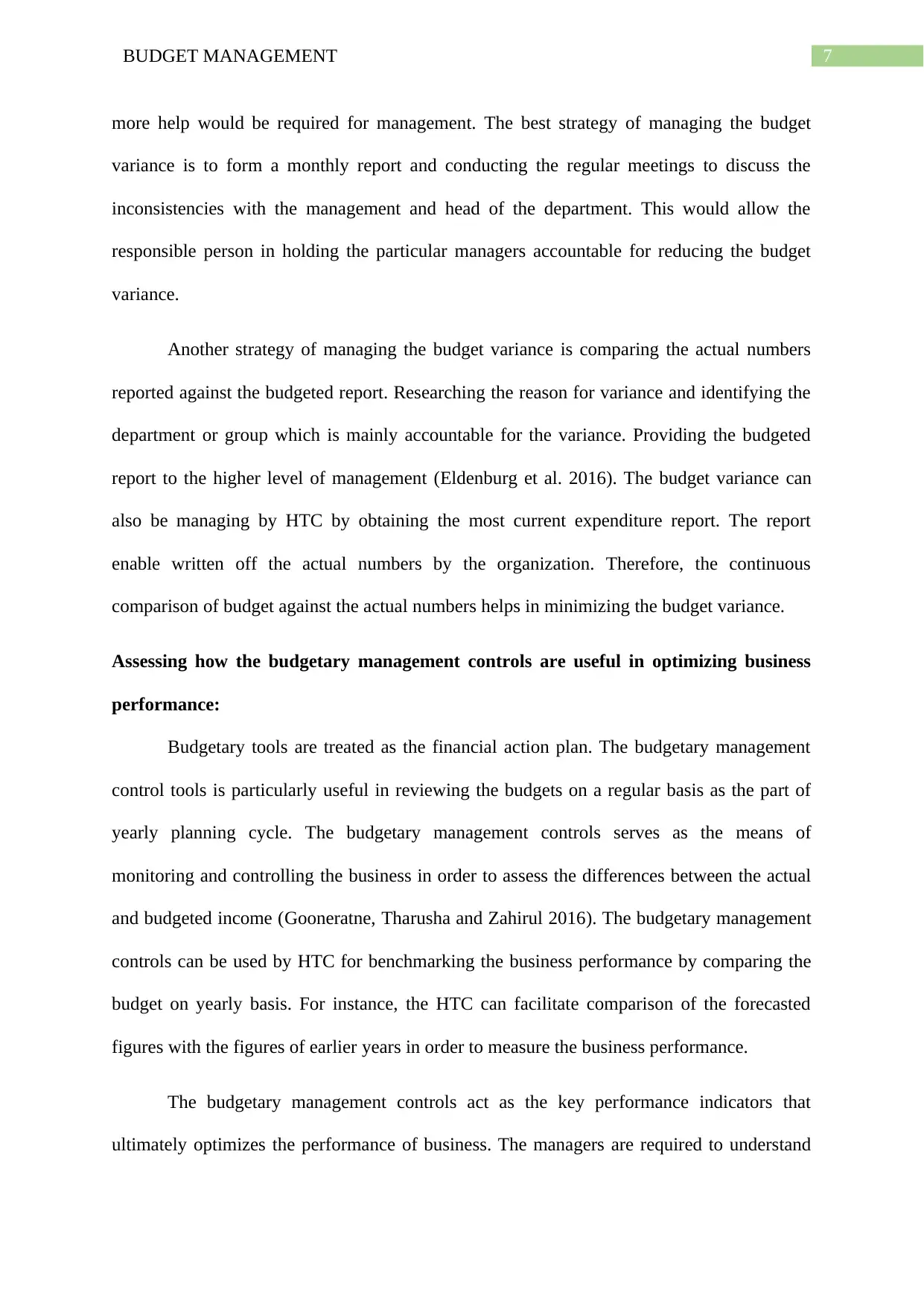
7BUDGET MANAGEMENT
more help would be required for management. The best strategy of managing the budget
variance is to form a monthly report and conducting the regular meetings to discuss the
inconsistencies with the management and head of the department. This would allow the
responsible person in holding the particular managers accountable for reducing the budget
variance.
Another strategy of managing the budget variance is comparing the actual numbers
reported against the budgeted report. Researching the reason for variance and identifying the
department or group which is mainly accountable for the variance. Providing the budgeted
report to the higher level of management (Eldenburg et al. 2016). The budget variance can
also be managing by HTC by obtaining the most current expenditure report. The report
enable written off the actual numbers by the organization. Therefore, the continuous
comparison of budget against the actual numbers helps in minimizing the budget variance.
Assessing how the budgetary management controls are useful in optimizing business
performance:
Budgetary tools are treated as the financial action plan. The budgetary management
control tools is particularly useful in reviewing the budgets on a regular basis as the part of
yearly planning cycle. The budgetary management controls serves as the means of
monitoring and controlling the business in order to assess the differences between the actual
and budgeted income (Gooneratne, Tharusha and Zahirul 2016). The budgetary management
controls can be used by HTC for benchmarking the business performance by comparing the
budget on yearly basis. For instance, the HTC can facilitate comparison of the forecasted
figures with the figures of earlier years in order to measure the business performance.
The budgetary management controls act as the key performance indicators that
ultimately optimizes the performance of business. The managers are required to understand
more help would be required for management. The best strategy of managing the budget
variance is to form a monthly report and conducting the regular meetings to discuss the
inconsistencies with the management and head of the department. This would allow the
responsible person in holding the particular managers accountable for reducing the budget
variance.
Another strategy of managing the budget variance is comparing the actual numbers
reported against the budgeted report. Researching the reason for variance and identifying the
department or group which is mainly accountable for the variance. Providing the budgeted
report to the higher level of management (Eldenburg et al. 2016). The budget variance can
also be managing by HTC by obtaining the most current expenditure report. The report
enable written off the actual numbers by the organization. Therefore, the continuous
comparison of budget against the actual numbers helps in minimizing the budget variance.
Assessing how the budgetary management controls are useful in optimizing business
performance:
Budgetary tools are treated as the financial action plan. The budgetary management
control tools is particularly useful in reviewing the budgets on a regular basis as the part of
yearly planning cycle. The budgetary management controls serves as the means of
monitoring and controlling the business in order to assess the differences between the actual
and budgeted income (Gooneratne, Tharusha and Zahirul 2016). The budgetary management
controls can be used by HTC for benchmarking the business performance by comparing the
budget on yearly basis. For instance, the HTC can facilitate comparison of the forecasted
figures with the figures of earlier years in order to measure the business performance.
The budgetary management controls act as the key performance indicators that
ultimately optimizes the performance of business. The managers are required to understand
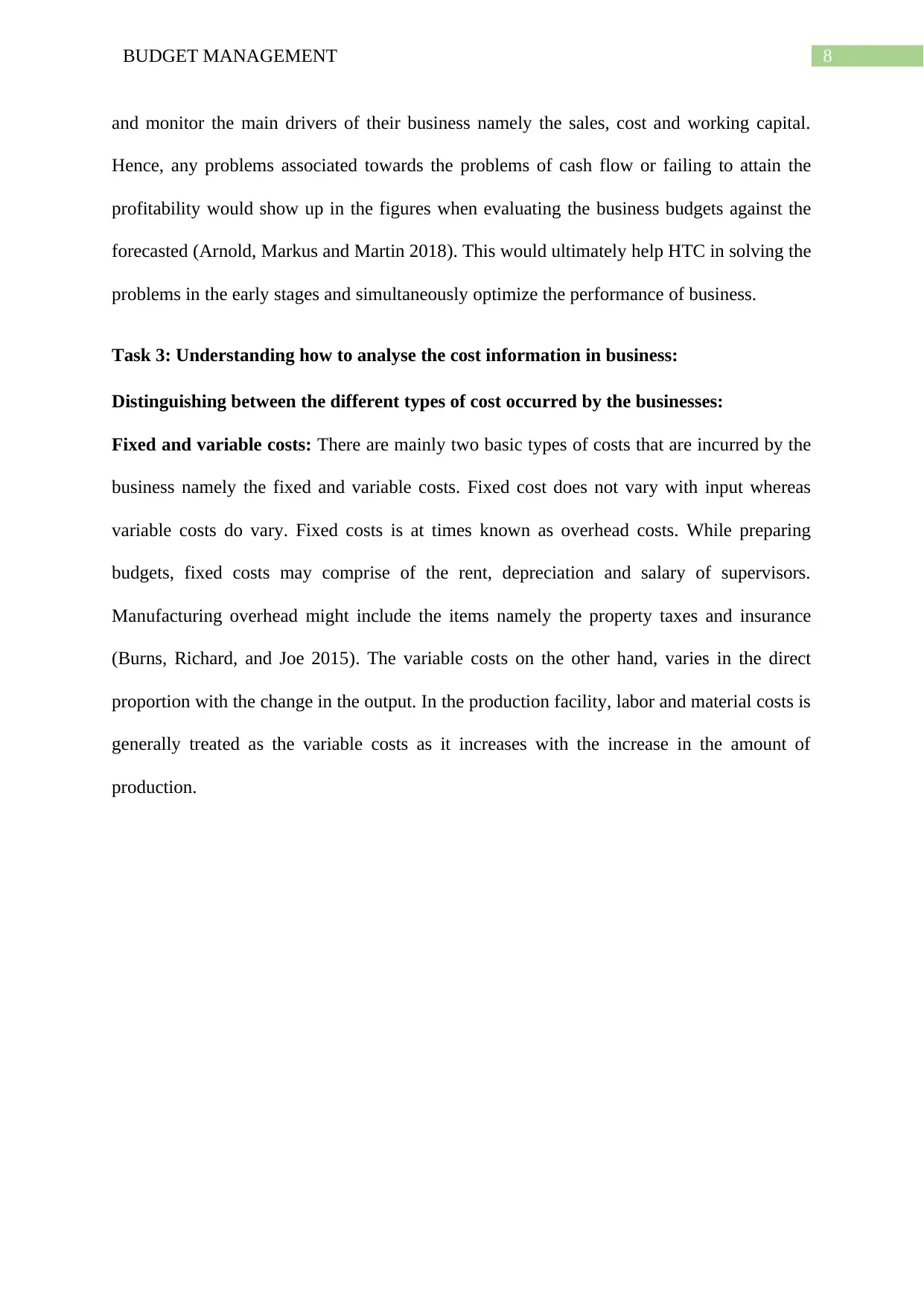
8BUDGET MANAGEMENT
and monitor the main drivers of their business namely the sales, cost and working capital.
Hence, any problems associated towards the problems of cash flow or failing to attain the
profitability would show up in the figures when evaluating the business budgets against the
forecasted (Arnold, Markus and Martin 2018). This would ultimately help HTC in solving the
problems in the early stages and simultaneously optimize the performance of business.
Task 3: Understanding how to analyse the cost information in business:
Distinguishing between the different types of cost occurred by the businesses:
Fixed and variable costs: There are mainly two basic types of costs that are incurred by the
business namely the fixed and variable costs. Fixed cost does not vary with input whereas
variable costs do vary. Fixed costs is at times known as overhead costs. While preparing
budgets, fixed costs may comprise of the rent, depreciation and salary of supervisors.
Manufacturing overhead might include the items namely the property taxes and insurance
(Burns, Richard, and Joe 2015). The variable costs on the other hand, varies in the direct
proportion with the change in the output. In the production facility, labor and material costs is
generally treated as the variable costs as it increases with the increase in the amount of
production.
and monitor the main drivers of their business namely the sales, cost and working capital.
Hence, any problems associated towards the problems of cash flow or failing to attain the
profitability would show up in the figures when evaluating the business budgets against the
forecasted (Arnold, Markus and Martin 2018). This would ultimately help HTC in solving the
problems in the early stages and simultaneously optimize the performance of business.
Task 3: Understanding how to analyse the cost information in business:
Distinguishing between the different types of cost occurred by the businesses:
Fixed and variable costs: There are mainly two basic types of costs that are incurred by the
business namely the fixed and variable costs. Fixed cost does not vary with input whereas
variable costs do vary. Fixed costs is at times known as overhead costs. While preparing
budgets, fixed costs may comprise of the rent, depreciation and salary of supervisors.
Manufacturing overhead might include the items namely the property taxes and insurance
(Burns, Richard, and Joe 2015). The variable costs on the other hand, varies in the direct
proportion with the change in the output. In the production facility, labor and material costs is
generally treated as the variable costs as it increases with the increase in the amount of
production.

9BUDGET MANAGEMENT
Figure 2: Figure representing Fixed Cost and Variable Costs
(Source: Burns, Richard, and Joe 2015)
Product and Period Costs: The term product and period costs is identical to the direct and
indirect costs. Product costs are those costs where the accounting system of the company is
associated directly with the output and that are used in the valuation of the inventory (Chak,
Suet and Heidi 2015). The period cost on the other hand are charged with the expenditure of
the current period. The period cost is not treated as the product cost therefore they are not
associated with valuation of inventories.
Figure 2: Figure representing Fixed Cost and Variable Costs
(Source: Burns, Richard, and Joe 2015)
Product and Period Costs: The term product and period costs is identical to the direct and
indirect costs. Product costs are those costs where the accounting system of the company is
associated directly with the output and that are used in the valuation of the inventory (Chak,
Suet and Heidi 2015). The period cost on the other hand are charged with the expenditure of
the current period. The period cost is not treated as the product cost therefore they are not
associated with valuation of inventories.
Secure Best Marks with AI Grader
Need help grading? Try our AI Grader for instant feedback on your assignments.
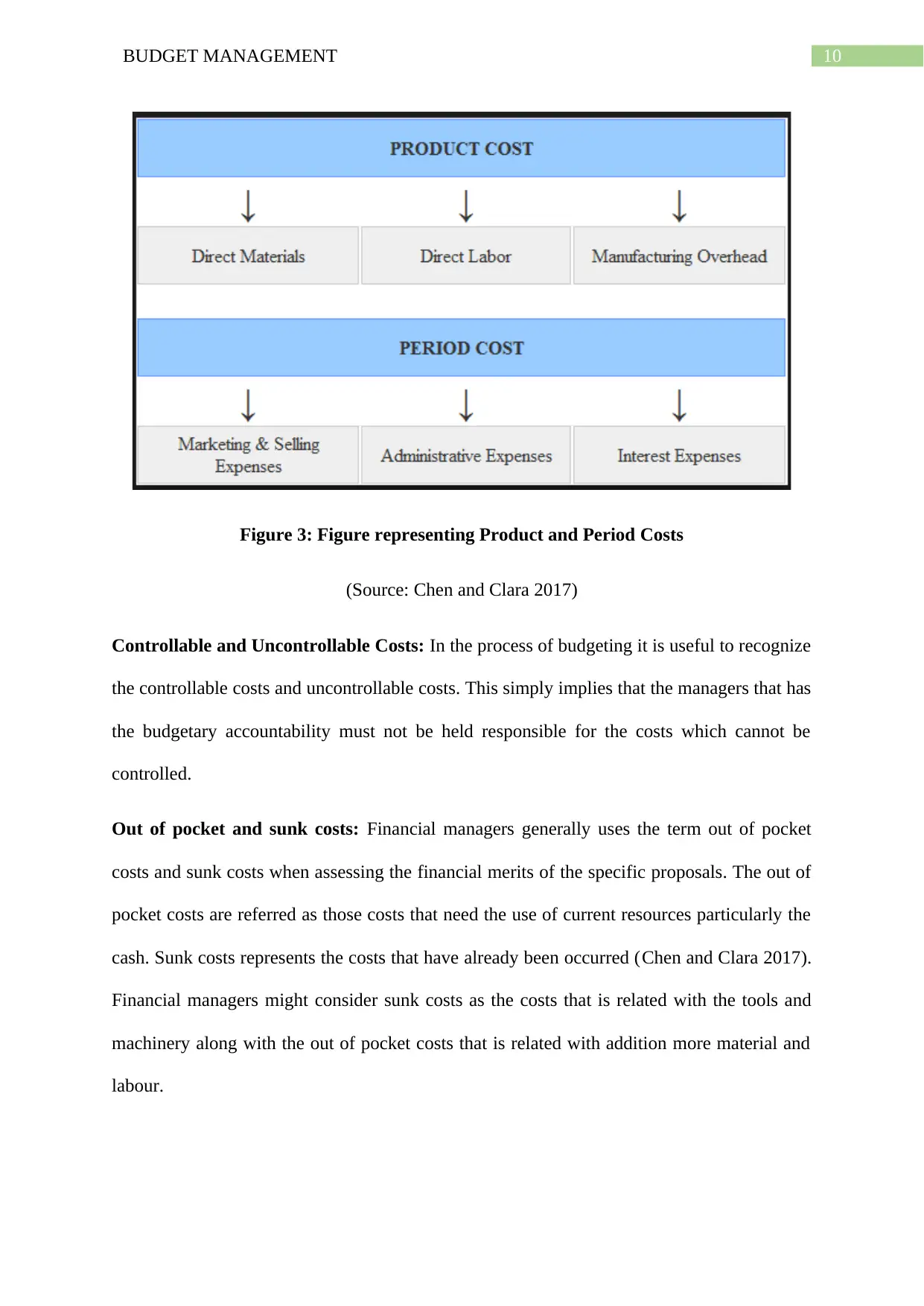
10BUDGET MANAGEMENT
Figure 3: Figure representing Product and Period Costs
(Source: Chen and Clara 2017)
Controllable and Uncontrollable Costs: In the process of budgeting it is useful to recognize
the controllable costs and uncontrollable costs. This simply implies that the managers that has
the budgetary accountability must not be held responsible for the costs which cannot be
controlled.
Out of pocket and sunk costs: Financial managers generally uses the term out of pocket
costs and sunk costs when assessing the financial merits of the specific proposals. The out of
pocket costs are referred as those costs that need the use of current resources particularly the
cash. Sunk costs represents the costs that have already been occurred (Chen and Clara 2017).
Financial managers might consider sunk costs as the costs that is related with the tools and
machinery along with the out of pocket costs that is related with addition more material and
labour.
Figure 3: Figure representing Product and Period Costs
(Source: Chen and Clara 2017)
Controllable and Uncontrollable Costs: In the process of budgeting it is useful to recognize
the controllable costs and uncontrollable costs. This simply implies that the managers that has
the budgetary accountability must not be held responsible for the costs which cannot be
controlled.
Out of pocket and sunk costs: Financial managers generally uses the term out of pocket
costs and sunk costs when assessing the financial merits of the specific proposals. The out of
pocket costs are referred as those costs that need the use of current resources particularly the
cash. Sunk costs represents the costs that have already been occurred (Chen and Clara 2017).
Financial managers might consider sunk costs as the costs that is related with the tools and
machinery along with the out of pocket costs that is related with addition more material and
labour.
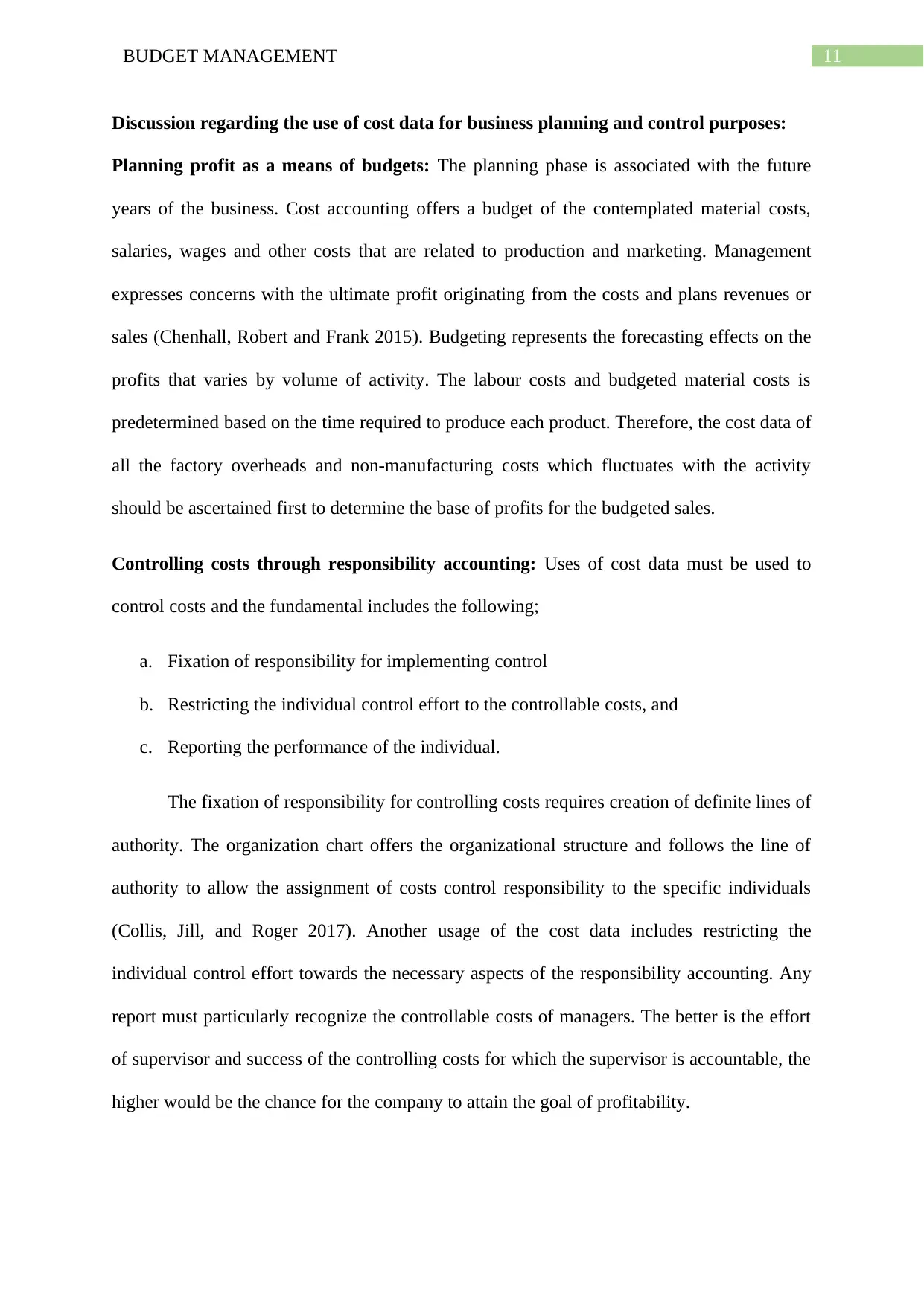
11BUDGET MANAGEMENT
Discussion regarding the use of cost data for business planning and control purposes:
Planning profit as a means of budgets: The planning phase is associated with the future
years of the business. Cost accounting offers a budget of the contemplated material costs,
salaries, wages and other costs that are related to production and marketing. Management
expresses concerns with the ultimate profit originating from the costs and plans revenues or
sales (Chenhall, Robert and Frank 2015). Budgeting represents the forecasting effects on the
profits that varies by volume of activity. The labour costs and budgeted material costs is
predetermined based on the time required to produce each product. Therefore, the cost data of
all the factory overheads and non-manufacturing costs which fluctuates with the activity
should be ascertained first to determine the base of profits for the budgeted sales.
Controlling costs through responsibility accounting: Uses of cost data must be used to
control costs and the fundamental includes the following;
a. Fixation of responsibility for implementing control
b. Restricting the individual control effort to the controllable costs, and
c. Reporting the performance of the individual.
The fixation of responsibility for controlling costs requires creation of definite lines of
authority. The organization chart offers the organizational structure and follows the line of
authority to allow the assignment of costs control responsibility to the specific individuals
(Collis, Jill, and Roger 2017). Another usage of the cost data includes restricting the
individual control effort towards the necessary aspects of the responsibility accounting. Any
report must particularly recognize the controllable costs of managers. The better is the effort
of supervisor and success of the controlling costs for which the supervisor is accountable, the
higher would be the chance for the company to attain the goal of profitability.
Discussion regarding the use of cost data for business planning and control purposes:
Planning profit as a means of budgets: The planning phase is associated with the future
years of the business. Cost accounting offers a budget of the contemplated material costs,
salaries, wages and other costs that are related to production and marketing. Management
expresses concerns with the ultimate profit originating from the costs and plans revenues or
sales (Chenhall, Robert and Frank 2015). Budgeting represents the forecasting effects on the
profits that varies by volume of activity. The labour costs and budgeted material costs is
predetermined based on the time required to produce each product. Therefore, the cost data of
all the factory overheads and non-manufacturing costs which fluctuates with the activity
should be ascertained first to determine the base of profits for the budgeted sales.
Controlling costs through responsibility accounting: Uses of cost data must be used to
control costs and the fundamental includes the following;
a. Fixation of responsibility for implementing control
b. Restricting the individual control effort to the controllable costs, and
c. Reporting the performance of the individual.
The fixation of responsibility for controlling costs requires creation of definite lines of
authority. The organization chart offers the organizational structure and follows the line of
authority to allow the assignment of costs control responsibility to the specific individuals
(Collis, Jill, and Roger 2017). Another usage of the cost data includes restricting the
individual control effort towards the necessary aspects of the responsibility accounting. Any
report must particularly recognize the controllable costs of managers. The better is the effort
of supervisor and success of the controlling costs for which the supervisor is accountable, the
higher would be the chance for the company to attain the goal of profitability.
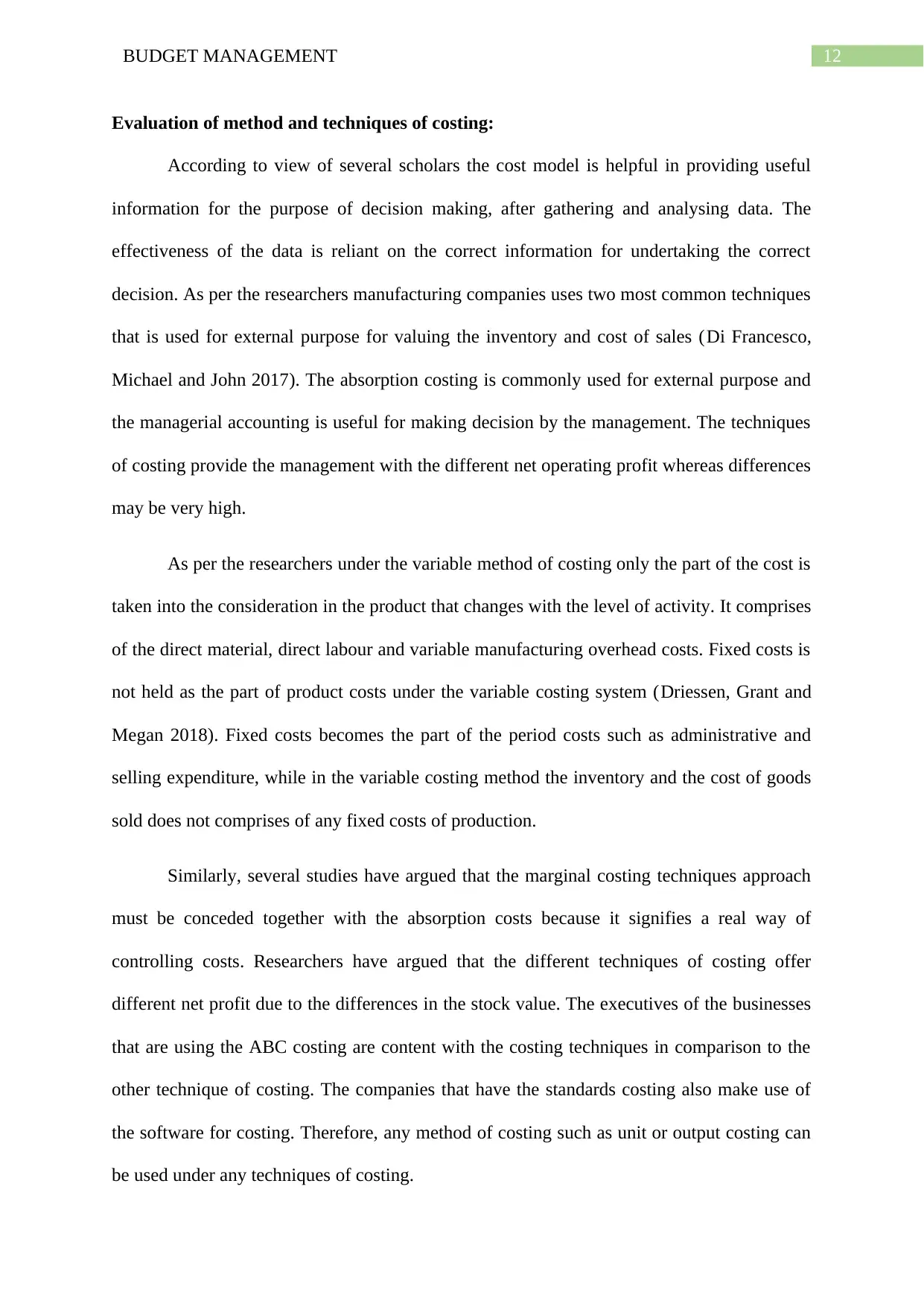
12BUDGET MANAGEMENT
Evaluation of method and techniques of costing:
According to view of several scholars the cost model is helpful in providing useful
information for the purpose of decision making, after gathering and analysing data. The
effectiveness of the data is reliant on the correct information for undertaking the correct
decision. As per the researchers manufacturing companies uses two most common techniques
that is used for external purpose for valuing the inventory and cost of sales (Di Francesco,
Michael and John 2017). The absorption costing is commonly used for external purpose and
the managerial accounting is useful for making decision by the management. The techniques
of costing provide the management with the different net operating profit whereas differences
may be very high.
As per the researchers under the variable method of costing only the part of the cost is
taken into the consideration in the product that changes with the level of activity. It comprises
of the direct material, direct labour and variable manufacturing overhead costs. Fixed costs is
not held as the part of product costs under the variable costing system (Driessen, Grant and
Megan 2018). Fixed costs becomes the part of the period costs such as administrative and
selling expenditure, while in the variable costing method the inventory and the cost of goods
sold does not comprises of any fixed costs of production.
Similarly, several studies have argued that the marginal costing techniques approach
must be conceded together with the absorption costs because it signifies a real way of
controlling costs. Researchers have argued that the different techniques of costing offer
different net profit due to the differences in the stock value. The executives of the businesses
that are using the ABC costing are content with the costing techniques in comparison to the
other technique of costing. The companies that have the standards costing also make use of
the software for costing. Therefore, any method of costing such as unit or output costing can
be used under any techniques of costing.
Evaluation of method and techniques of costing:
According to view of several scholars the cost model is helpful in providing useful
information for the purpose of decision making, after gathering and analysing data. The
effectiveness of the data is reliant on the correct information for undertaking the correct
decision. As per the researchers manufacturing companies uses two most common techniques
that is used for external purpose for valuing the inventory and cost of sales (Di Francesco,
Michael and John 2017). The absorption costing is commonly used for external purpose and
the managerial accounting is useful for making decision by the management. The techniques
of costing provide the management with the different net operating profit whereas differences
may be very high.
As per the researchers under the variable method of costing only the part of the cost is
taken into the consideration in the product that changes with the level of activity. It comprises
of the direct material, direct labour and variable manufacturing overhead costs. Fixed costs is
not held as the part of product costs under the variable costing system (Driessen, Grant and
Megan 2018). Fixed costs becomes the part of the period costs such as administrative and
selling expenditure, while in the variable costing method the inventory and the cost of goods
sold does not comprises of any fixed costs of production.
Similarly, several studies have argued that the marginal costing techniques approach
must be conceded together with the absorption costs because it signifies a real way of
controlling costs. Researchers have argued that the different techniques of costing offer
different net profit due to the differences in the stock value. The executives of the businesses
that are using the ABC costing are content with the costing techniques in comparison to the
other technique of costing. The companies that have the standards costing also make use of
the software for costing. Therefore, any method of costing such as unit or output costing can
be used under any techniques of costing.
Paraphrase This Document
Need a fresh take? Get an instant paraphrase of this document with our AI Paraphraser
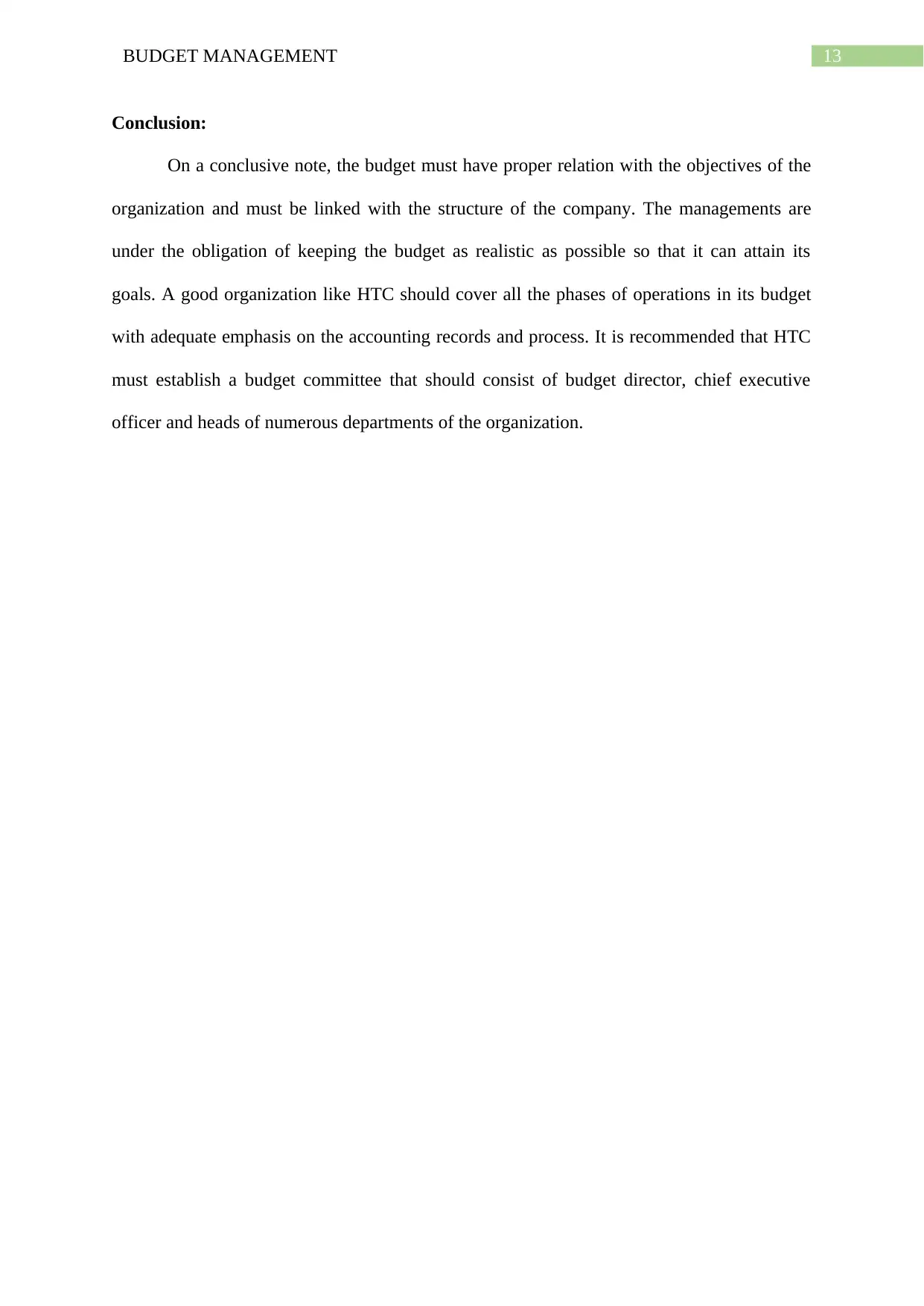
13BUDGET MANAGEMENT
Conclusion:
On a conclusive note, the budget must have proper relation with the objectives of the
organization and must be linked with the structure of the company. The managements are
under the obligation of keeping the budget as realistic as possible so that it can attain its
goals. A good organization like HTC should cover all the phases of operations in its budget
with adequate emphasis on the accounting records and process. It is recommended that HTC
must establish a budget committee that should consist of budget director, chief executive
officer and heads of numerous departments of the organization.
Conclusion:
On a conclusive note, the budget must have proper relation with the objectives of the
organization and must be linked with the structure of the company. The managements are
under the obligation of keeping the budget as realistic as possible so that it can attain its
goals. A good organization like HTC should cover all the phases of operations in its budget
with adequate emphasis on the accounting records and process. It is recommended that HTC
must establish a budget committee that should consist of budget director, chief executive
officer and heads of numerous departments of the organization.
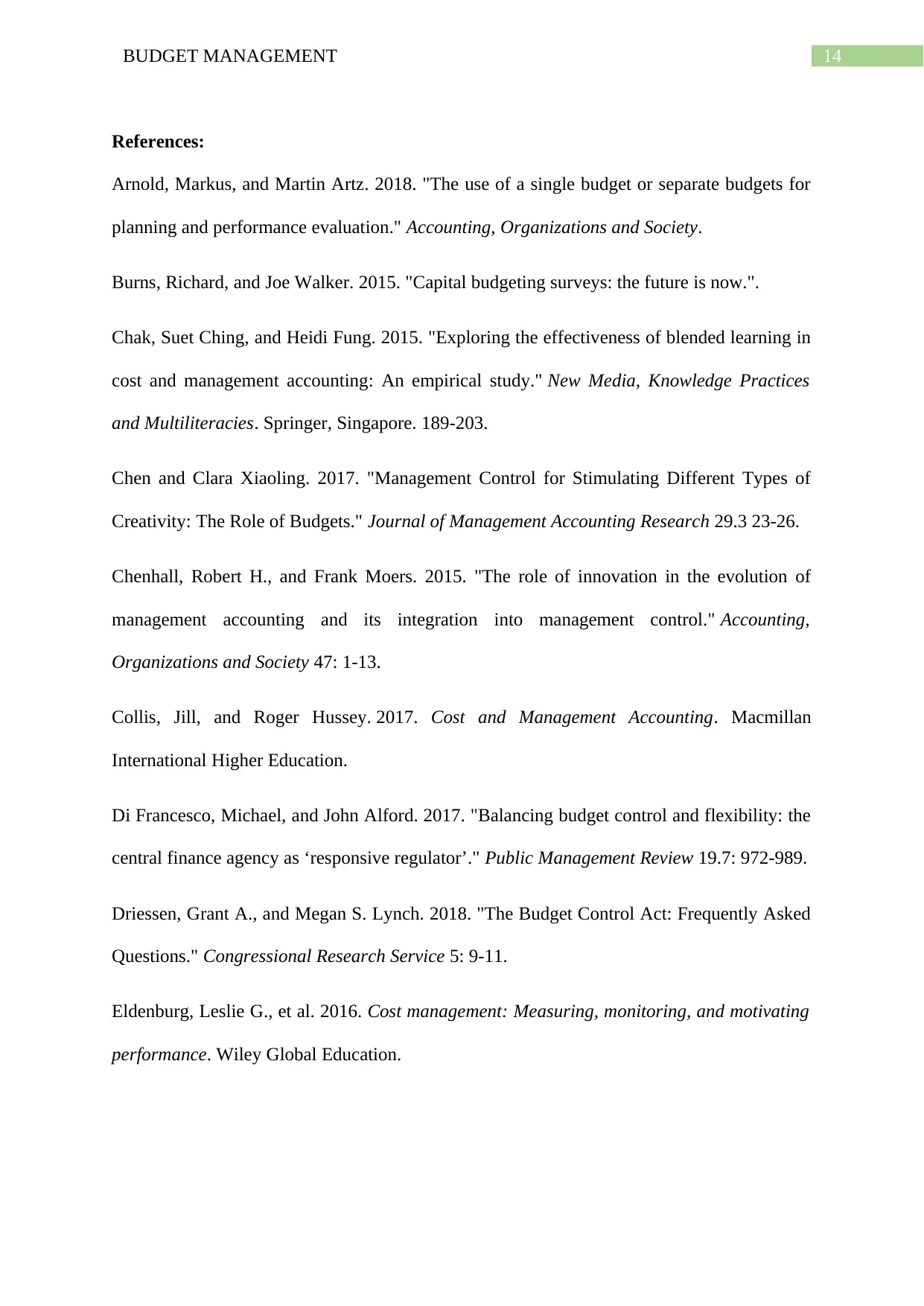
14BUDGET MANAGEMENT
References:
Arnold, Markus, and Martin Artz. 2018. "The use of a single budget or separate budgets for
planning and performance evaluation." Accounting, Organizations and Society.
Burns, Richard, and Joe Walker. 2015. "Capital budgeting surveys: the future is now.".
Chak, Suet Ching, and Heidi Fung. 2015. "Exploring the effectiveness of blended learning in
cost and management accounting: An empirical study." New Media, Knowledge Practices
and Multiliteracies. Springer, Singapore. 189-203.
Chen and Clara Xiaoling. 2017. "Management Control for Stimulating Different Types of
Creativity: The Role of Budgets." Journal of Management Accounting Research 29.3 23-26.
Chenhall, Robert H., and Frank Moers. 2015. "The role of innovation in the evolution of
management accounting and its integration into management control." Accounting,
Organizations and Society 47: 1-13.
Collis, Jill, and Roger Hussey. 2017. Cost and Management Accounting. Macmillan
International Higher Education.
Di Francesco, Michael, and John Alford. 2017. "Balancing budget control and flexibility: the
central finance agency as ‘responsive regulator’." Public Management Review 19.7: 972-989.
Driessen, Grant A., and Megan S. Lynch. 2018. "The Budget Control Act: Frequently Asked
Questions." Congressional Research Service 5: 9-11.
Eldenburg, Leslie G., et al. 2016. Cost management: Measuring, monitoring, and motivating
performance. Wiley Global Education.
References:
Arnold, Markus, and Martin Artz. 2018. "The use of a single budget or separate budgets for
planning and performance evaluation." Accounting, Organizations and Society.
Burns, Richard, and Joe Walker. 2015. "Capital budgeting surveys: the future is now.".
Chak, Suet Ching, and Heidi Fung. 2015. "Exploring the effectiveness of blended learning in
cost and management accounting: An empirical study." New Media, Knowledge Practices
and Multiliteracies. Springer, Singapore. 189-203.
Chen and Clara Xiaoling. 2017. "Management Control for Stimulating Different Types of
Creativity: The Role of Budgets." Journal of Management Accounting Research 29.3 23-26.
Chenhall, Robert H., and Frank Moers. 2015. "The role of innovation in the evolution of
management accounting and its integration into management control." Accounting,
Organizations and Society 47: 1-13.
Collis, Jill, and Roger Hussey. 2017. Cost and Management Accounting. Macmillan
International Higher Education.
Di Francesco, Michael, and John Alford. 2017. "Balancing budget control and flexibility: the
central finance agency as ‘responsive regulator’." Public Management Review 19.7: 972-989.
Driessen, Grant A., and Megan S. Lynch. 2018. "The Budget Control Act: Frequently Asked
Questions." Congressional Research Service 5: 9-11.
Eldenburg, Leslie G., et al. 2016. Cost management: Measuring, monitoring, and motivating
performance. Wiley Global Education.
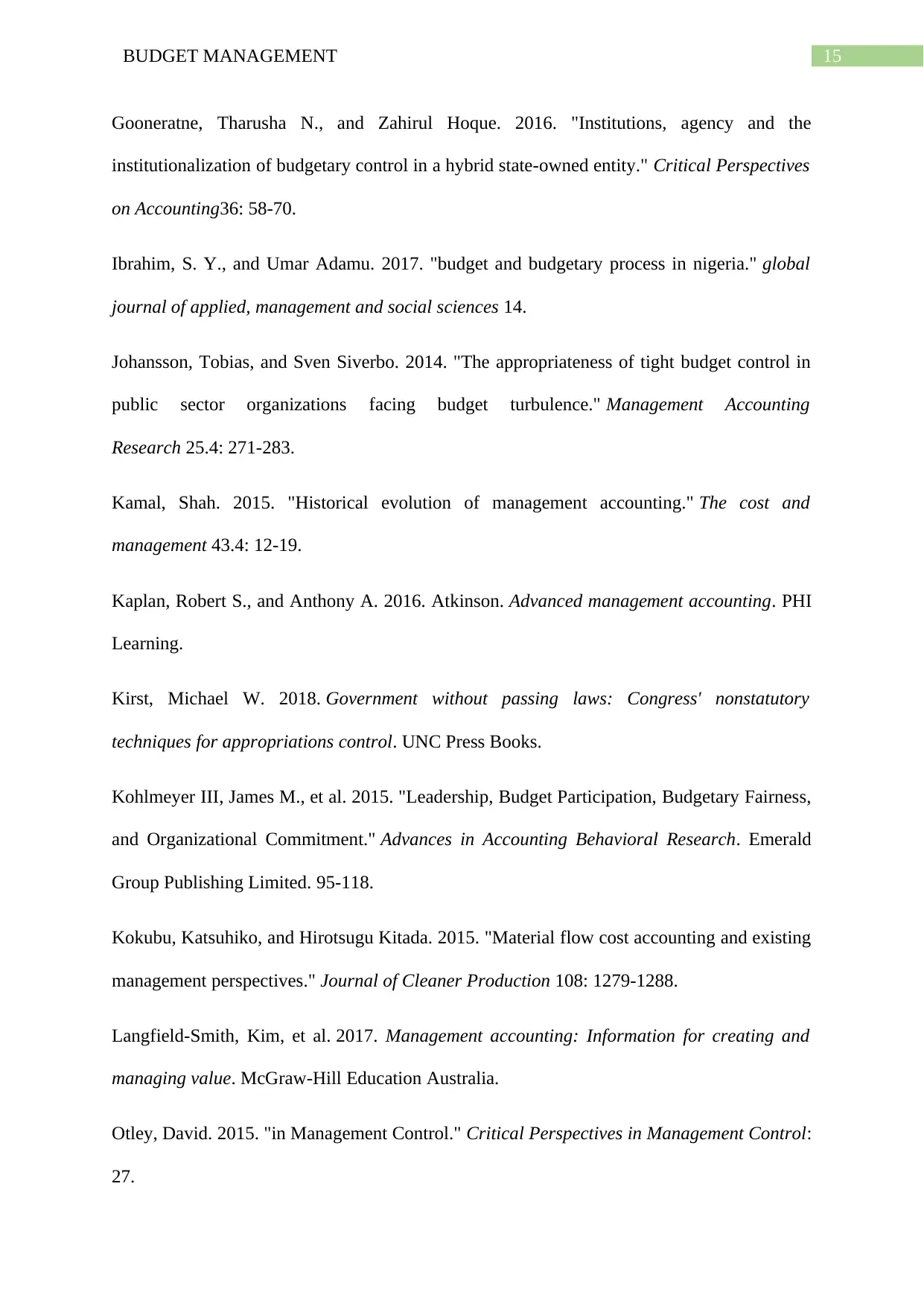
15BUDGET MANAGEMENT
Gooneratne, Tharusha N., and Zahirul Hoque. 2016. "Institutions, agency and the
institutionalization of budgetary control in a hybrid state-owned entity." Critical Perspectives
on Accounting36: 58-70.
Ibrahim, S. Y., and Umar Adamu. 2017. "budget and budgetary process in nigeria." global
journal of applied, management and social sciences 14.
Johansson, Tobias, and Sven Siverbo. 2014. "The appropriateness of tight budget control in
public sector organizations facing budget turbulence." Management Accounting
Research 25.4: 271-283.
Kamal, Shah. 2015. "Historical evolution of management accounting." The cost and
management 43.4: 12-19.
Kaplan, Robert S., and Anthony A. 2016. Atkinson. Advanced management accounting. PHI
Learning.
Kirst, Michael W. 2018. Government without passing laws: Congress' nonstatutory
techniques for appropriations control. UNC Press Books.
Kohlmeyer III, James M., et al. 2015. "Leadership, Budget Participation, Budgetary Fairness,
and Organizational Commitment." Advances in Accounting Behavioral Research. Emerald
Group Publishing Limited. 95-118.
Kokubu, Katsuhiko, and Hirotsugu Kitada. 2015. "Material flow cost accounting and existing
management perspectives." Journal of Cleaner Production 108: 1279-1288.
Langfield-Smith, Kim, et al. 2017. Management accounting: Information for creating and
managing value. McGraw-Hill Education Australia.
Otley, David. 2015. "in Management Control." Critical Perspectives in Management Control:
27.
Gooneratne, Tharusha N., and Zahirul Hoque. 2016. "Institutions, agency and the
institutionalization of budgetary control in a hybrid state-owned entity." Critical Perspectives
on Accounting36: 58-70.
Ibrahim, S. Y., and Umar Adamu. 2017. "budget and budgetary process in nigeria." global
journal of applied, management and social sciences 14.
Johansson, Tobias, and Sven Siverbo. 2014. "The appropriateness of tight budget control in
public sector organizations facing budget turbulence." Management Accounting
Research 25.4: 271-283.
Kamal, Shah. 2015. "Historical evolution of management accounting." The cost and
management 43.4: 12-19.
Kaplan, Robert S., and Anthony A. 2016. Atkinson. Advanced management accounting. PHI
Learning.
Kirst, Michael W. 2018. Government without passing laws: Congress' nonstatutory
techniques for appropriations control. UNC Press Books.
Kohlmeyer III, James M., et al. 2015. "Leadership, Budget Participation, Budgetary Fairness,
and Organizational Commitment." Advances in Accounting Behavioral Research. Emerald
Group Publishing Limited. 95-118.
Kokubu, Katsuhiko, and Hirotsugu Kitada. 2015. "Material flow cost accounting and existing
management perspectives." Journal of Cleaner Production 108: 1279-1288.
Langfield-Smith, Kim, et al. 2017. Management accounting: Information for creating and
managing value. McGraw-Hill Education Australia.
Otley, David. 2015. "in Management Control." Critical Perspectives in Management Control:
27.
Secure Best Marks with AI Grader
Need help grading? Try our AI Grader for instant feedback on your assignments.
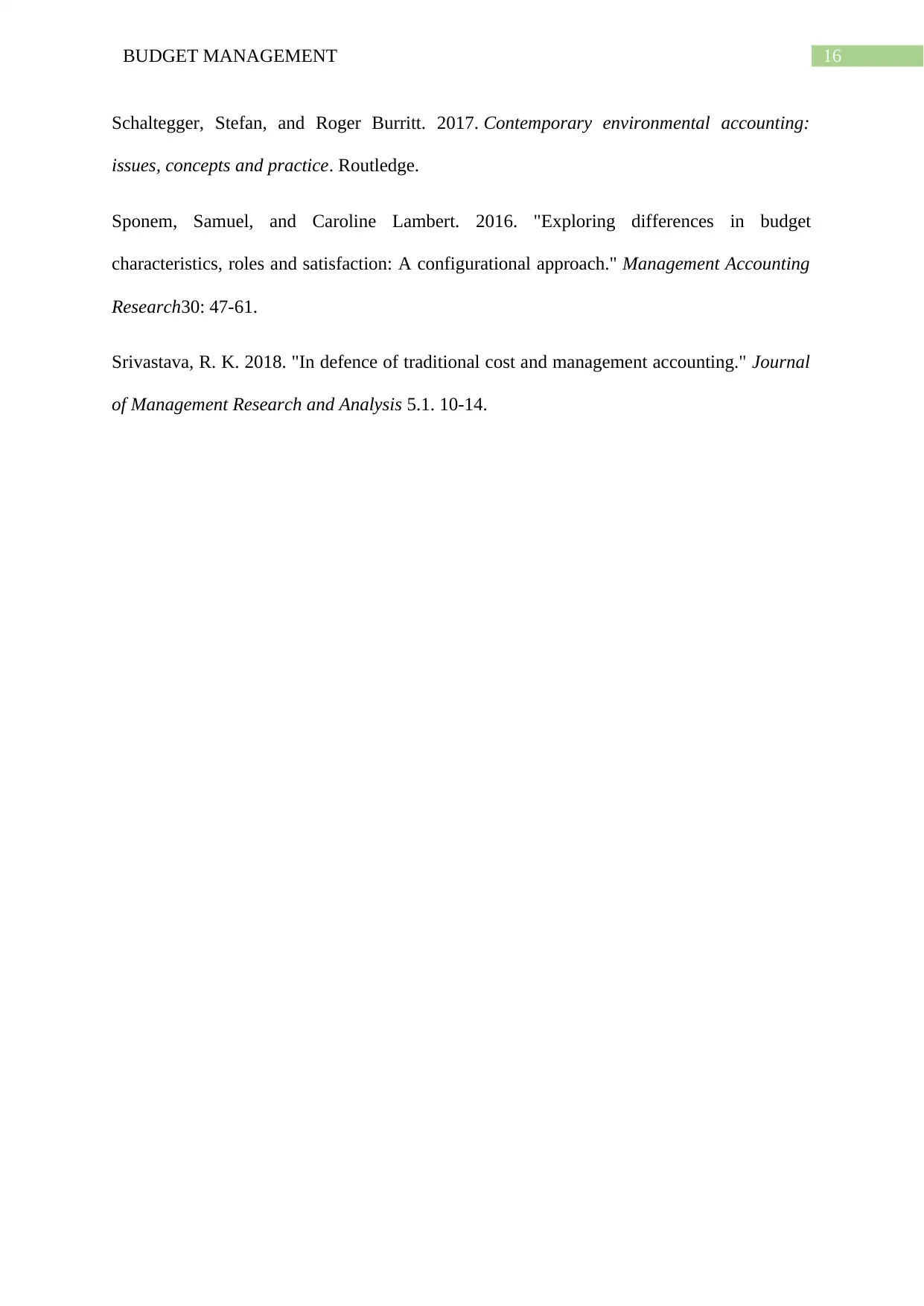
16BUDGET MANAGEMENT
Schaltegger, Stefan, and Roger Burritt. 2017. Contemporary environmental accounting:
issues, concepts and practice. Routledge.
Sponem, Samuel, and Caroline Lambert. 2016. "Exploring differences in budget
characteristics, roles and satisfaction: A configurational approach." Management Accounting
Research30: 47-61.
Srivastava, R. K. 2018. "In defence of traditional cost and management accounting." Journal
of Management Research and Analysis 5.1. 10-14.
Schaltegger, Stefan, and Roger Burritt. 2017. Contemporary environmental accounting:
issues, concepts and practice. Routledge.
Sponem, Samuel, and Caroline Lambert. 2016. "Exploring differences in budget
characteristics, roles and satisfaction: A configurational approach." Management Accounting
Research30: 47-61.
Srivastava, R. K. 2018. "In defence of traditional cost and management accounting." Journal
of Management Research and Analysis 5.1. 10-14.
1 out of 17
Related Documents
Your All-in-One AI-Powered Toolkit for Academic Success.
+13062052269
info@desklib.com
Available 24*7 on WhatsApp / Email
![[object Object]](/_next/static/media/star-bottom.7253800d.svg)
Unlock your academic potential
© 2024 | Zucol Services PVT LTD | All rights reserved.





